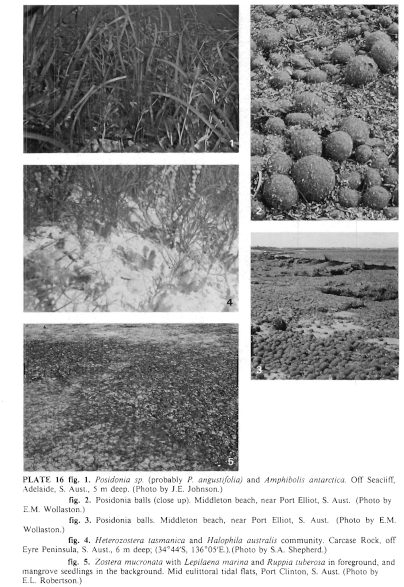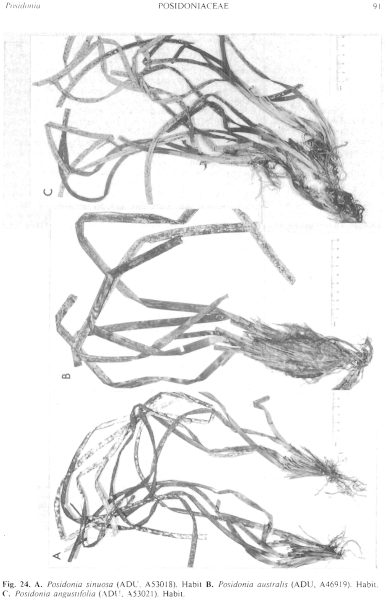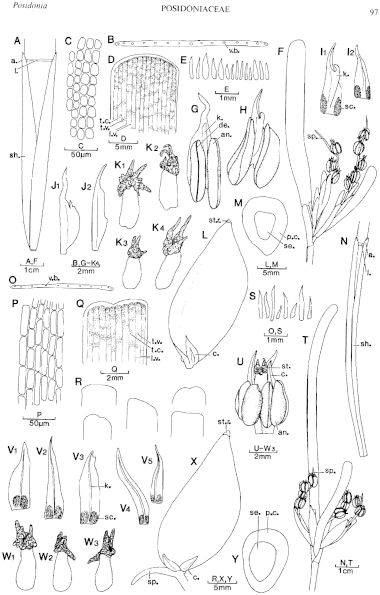|
|
|
|
|
|||||||||||
|
Electronic Flora of South Australia Species Fact Sheet
Phylum Magnoliophyta – Subphylum Seagrasses – Class Liliopsida – Subclass Alismatidae – Order Potamogetonales – Family Posidoniaceae
Selected citations: Green 1981: 5.
Rhizomes (Fig. 24C) 4–10 mm thick, laterally compressed, internodes mostly 1–6 cm long. Stems short, erect, sparingly branched, both stems and rhizomes retaining the fibrous remnants of the leaf sheaths. Leaves 2–3 per shoot; sheaths (Fig. 27N) 5–14 cm long, with margins overlapping for about 2/3 the length of the sheath; ligule about 1 mm long; auricles 1–2 (–5) mm long; persistent fine hair-like fibres remaining after senescence of the rest of the sheath, fibres pale-yellow to grey, hair-like in texture, less dense than in P. australis; blade (Fig. 270) flat, linear, (10–) 20–75 (–120) cm long, mostly 4–6 mm broad with 7–11 longitudinal veins uniting near the apex, epidermal cells (Fig. 27P) in surface view elongate, L/B 3–6, cell margins smooth; apex (Fig. 27Q,R) truncate to slightly notched, mostly oblique. Squamules (Fig. 27S) linear-lanceolate, 1–2 mm long. Inflorescence (Fig. 27T) usually hidden beneath the canopy of foliage leaves, peduncle 10–20 cm high, flattened and about 2 mm broad, spikes mostly 2–4, each terminating in a short spur. Flowers (Fig. 27U) 2–5 per spike; anther connective (Fig. 27V) about 5 mm long, lanceolate, margins usually entire, keel shallow; stigma (Fig. 27W) with 2 or 3 spurs, somewhat papillose. Fruit (Fig. 27X,Y) asymmetrically pyriform, about 2.5 cm long, somewhat compressed laterally.
Type from 4 km NE of Cape Naturaliste, W. Aust., 30 m deep (Cambridge, 22.xi.1976); UWA, 2856, in PERTH, isotypes in ADU, K.
Selected specimens: The isotype and Ward I., W of Hinders I., S. Aust., 18–22 m deep (Shepherd, 3.iii.1980; ADU, A50924). East Cove, Pearson I., S. Aust., 20–23 m deep (Shepherd & Turner, 29.iii.1982; ADU, A53021). North Bay, Pearson I., S. Aust., 14 m deep (Shepherd, 12.i.1969; ADU, A46466). Investigator Strait, S. Aust., 32 m deep (Watson, 23.i.1971; ADU, A40993). Off Broadway, Glenelg, S. Aust., 8 m deep (Shepherd, 3.xi.1968; ADU, A46474). Off Semaphore, near Adelaide, S. Aust., 15 m deep (Shepherd, 8.xi.1977; ADU, A48844). Off Blowhole Creek, 10 km SE of Cape Jervis, S. Aust., 12–15 m deep (Shepherd, 15.ix.1981; ADU, A52562). Abalone Cove, West I., S. Aust., 5 m deep (Shepherd, 22.ix.1977; ADU, A48256). Port MacDonnell, S. Aust., 2 m deep (Shepherd, 26.x.1977; ADU, A48848).
Distribution: From Houtmans Abrolhos, W. Aust., southwards and eastwards to Port MacDonnell, S. Aust. P. angustifolia grows subtidally from 2–35 m deep. It frequently grows in deeper water than P. australis but it can grow sympatrically with either P. australis or P. sinuosa. In its deeper range it is often found in association with Heterozostera tasmanica or Halophila australis and in sheltered positions in its shallower range in association with Amphibolis antarctica (P1. 16 fig. 1). The rhizomes of P. angustifolia usually extend more or less horizontally within the substrate at a depth of about 10–20 cm with the roots penetrating to a depth of about 30–60 cm.
Taxonomic notes: Some specimens from the eastern limit of its range, e.g. ADU, A48848 from Port MacDonnell, S. Aust., represent a very broad leaved form and may be intergrades between P. angustifolia and P. australis.
References:
CAMBRIDGE, M.L. & KUO, J. (1979). Two new species of seagrasses from Australia, Posidonia sinuosa and P. angustifolia (Posidoniaceae). Aquat. Bot, 6, 307–328.
GREEN, J.W. (1981). Census of the Vascular Plants of Western Australia. (Western Australian Herbarium: South Perth.)
The Marine Benthic Flora of Southern Australia Part I complete list of references.
Publication:
Womersley, H.B.S. (31 May, 1984)
The Marine Benthic Flora of Southern Australia
Part I
©Board of the Botanic Gardens and State Herbarium, Government of South Australia
Illustrations in Womersley Part I, 1984: PLATE 16 fig. 1; FIGS 24C, 27 N–Y.

Plate 16 enlarge
PLATE 16 Fig. 1. Posidonia sp. (probably P. angustifolia) and Amphibolis antarctica. Off Seacliff, Adelaide, S. Aust., 5 m deep. (Photo by J.E. Johnson.)
Fig. 2. Posidonia balls (close up). Middleton beach, near Port Elliot, S. Aust. (Photo by E.M. Wollaston.)
Fig. 3. Posidonia balls. Middleton beach, near Port Elliot, S. Aust. (Photo by E.M. Wollaston.)
Fig. 4. Heterozostera tasmanica and Halophila australis community. Carcase Rock, off Eyre Peninsula, S. Aust., 6 m deep; (34°44'S, 136°05'E.). (Photo by S.A. Shepherd.)
Fig. 5. Zostera mucronata with Lepilaena marina and Ruppia tuberosa in foreground, and mangrove seedlings in the background. Mid eulittoral tidal flats, Port Clinton, S. Aust. (Photo by E.L. Robertson.)

Figure 24 enlarge
Fig. 24. A. Posidonia sinuosa (ADU, A53018). Habit B. Posidonia australis (ADU, A46919). Habit. C. Posidonia angustifolia (ADU, A53021). Habit.

Figure 27 enlarge
Fig. 27 A–M Posidonia australis. A. Portion of leaf (adaxial view) showing sheath (sh.) margin overlap, ligule (I.) and auricles (a.). B. T.S. mid portion of leaf blade showing vascular bundles (v.b.). C. Epidermis of leaf blade (surface view) showing isobilateral cells. D. Leaf apex showing longitudinal veins (tv.), transverse veins (t.v.) and tannin cells (t.c.). E. Squamules showing shape and size variation. F. Inflorescence of 2 spikes showing terminal spur (sp.). G. Stamen showing 2 young anthers (an.), line of dehiscence (co.) and elongate connective with keel (k.). H. Stamen showing 2 dehisced anthers and connective with hooked keel. I1,I2. Connectives (abaxial view) showing scar (sc.) after anther fall. J1,J2. Connectives (side view) showing well-developed keel. K1-K4. Ovaries and stigmas showing variation in lobing. L. Fruit showing persistent anther connectives (c.) and stigma remnant (st.r.). M. T.S. fruit showing pericarp (p.c.) and seed (se.). (A–G, J1,J2, K2-K4 from ADU, A45924. H, II,12, K1 from ADU, A48004. L, M from ADU, A41271.)
N–Y Posidonia angustifolia. N. Portion of leaf (adaxial view) showing sheath (sh.) margin overlap, ligule (l) and auricles (a.) 0. T.S. mid portion of leaf blade showing vascular bundles (vb.), P. Epidermis of leaf blade (surface view) showing elongate cells. Q. Leaf apex showing longitudinal veins (l.v.), transverse veins (t.v.) and tannin cells (t.c.) R. Leaf apices, variation in shape. S. Squamules showing shape and size variation. T. Inflorescence of 3 spikes showing terminal spur (sp.). U. Flower showing dehisced anthers (an.), elongate connectives (c.), ovary and lobed stigma (st.). V1-V5. Connectives after fall of anthers showing scars (sc.) and shallow keel (k.). W1-W3. Ovaries and stigmas, showing variation in stigma lobing. X. Fruit showing terminal spur (sp.), persistent connective (c.) and stigma remnant (st.r.). Y. T.S. Fruit showing pericarp (p.c.) and seed (se.). (N–Q, S, U from ADU, A48844. R from ADU, A50924. T,V1-V5,W1-W3 from ADU, A46474. X, Y from ADU, A46466.)

|
Email Contact: State Herbarium of South Australia |

|